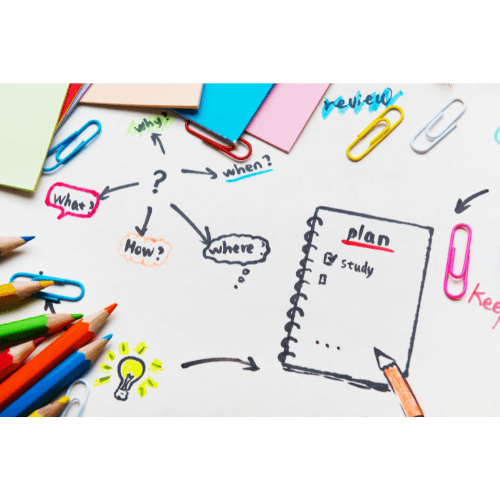
Identifying And Selecting Aims
Why setting clear aims matter?

You’re planning a surprise birthday party for your best friend. You want it to be perfect and unforgettable. To make this happen, you need to set clear aims for each part of the party. So, how would you go about it?
The reason of the party is to celebrate your friend’s birthday and make him/her feel special. This is the main aim that drives all your planning efforts.
To achieve this, you need to think about what else needs to happen. You might have to create a festive atmosphere by decorating the venue or to keep guests entertained with fun activities. These smaller goals support your main aim of making the party enjoyable for your friend.
While planning the party, you also want to work on improving your event-planning skills. At the same time, you want to be more organized or better at managing time. These are focused on your personal growth and development.
Finally, you break down the party into stages. You’ll need to send out invitations, set up the decorations, welcome the guests, and surprise your friend. Each of these stages has its own specific goal, such as ensuring all guests know the party details, creating a welcoming environment, and making sure the surprise goes off without a hitch.
Planning a good lesson is like planning a good party—it needs clear goals. By using the four types of aims—main, subsidiary, personal, and stage—you can make sure your lessons are organized, focused, and effective.
Identifying aims of a lesson

A real-world scenario
Read the teacher story 3: Thilini’s struggle with lesson aims
Now, answer these questions.
- What was Thilini’s initial understanding of the main objective? How did her understanding change after receiving feedback from her supervisor?
- How did Thilini differentiate between subsidiary objectives and the main objective? Provide an example of a subsidiary aim she might use in a lesson on past simple tense.
- Describe what personal objectives are and give an example of a personal aim Thilini might set for herself as a teacher.
- What are stage objectives, and why did Thilini find them challenging to create? Give an example of a stage objective she might use in the presentation stage of a grammar lesson.
The four-types of lesson aims
Main aim
A main aim in an ESL lesson plan is the key objective you want students to reach by the lesson’s end. It targets the main language point or skill being taught and practiced, such as a grammar rule, vocabulary list, or language function.
‘Students will be able to form and use past simple tense to describe completed actions in the past.’
Subsidiary aims
Subsidiary aims are secondary objectives that support the achievement of the main aim. These often focus on language skills or components that complement the main aim.
‘Students recognize regular and irregular verb forms.’
‘Students can use past-related time expressions like ‘yesterday’ or ‘last week.’
Personal aims
Personal aims are goals the teacher sets for their own professional development during the lesson. These focus on improving teaching techniques or classroom management.
‘Give clearer instructions’
‘Manage classroom time more effectively’
‘Increase student interaction’
Stage aims
Stage aims are specific goals for individual parts (or stages) of the lesson. They clarify the purpose of each activity and how it contributes to the overall lesson objective.
‘Activate students’ prior knowledge of the past tense’
‘Introduce the structure of the past simple tense’
How to write lesson aims properly

Main aim
“By the end of the lesson, students will be able to describe their favorite holiday destination using at least 5 new adjectives and explain why they like it.”
When writing the main objective, be specific and clear about what students should be able to do by the end of the lesson. Here are tips to help you write an effective main aim.
- Specify the target skill or language focus
- Keep it realistic for the students’ level
- The aim should be achievable within the lesson’s time frame
- Use verbs that show observable results
- Avoid overly complex or too simplistic goals.
- Focus on what students will achieve (NOT what teacher will do).
- Link the main aim to a topic or theme to make it meaningful.
- If the lesson is part of a series, make sure that the aim builds on previous lessons or sets the foundation for upcoming ones.
Determine which of the tips mentioned above have been applied in the following main objectives. Some are addressing to more than one.
“To teach students how to describe their daily routines using the present simple tense in the context of ‘A Day in My Life’.”
“To enable students to form affirmative and negative sentences in the past simple tense.”
“To teach students how to use comparative adjectives to describe differences between objects.”
“By the end of the lesson, students will be able to use 5 adjectives to describe people’s physical appearance in speaking tasks.”
Say what is/are missing in the following main objectives.
“Students will learn English.”
“Students will talk about their weekend.”
“Students will understand how to use adjectives.”
Subsidiary aims
Main Aim: “To enable students to describe their daily routine using the present simple tense.”
Subsidiary aims:
1.“To introduce time-related vocabulary (e.g., ‘in the morning,’ ‘at night’).”
2.“To teach the structure of present simple sentences (‘I wake up at 7 a.m.’).”
3. To practice using adverbs of frequency (‘always,’ ‘sometimes,’ ‘never’) in sentences.”
When writing subsidiary objectives in an ESL lesson, you need to focus on the skills or language points that support the main objective. Subsidiary objectives represent the building blocks necessary for students to achieve the main objective effectively. Here are some important considerations:
- Subsidiary aims should directly contribute to the achievement of the main aim.
- Focus on supporting language points such as grammar, vocabulary, pronunciation, or functional language
- If the main aim focuses on one skill, subsidiary aims can target related skills that prepare students for success.
- Include subskills that support the main aim.
- Avoid vague statements.
- Make sure the subsidiary aims are suitable for the students’ language level.
- Subsidiary aims should reflect the sequence of learning activities in the lesson.
- Make sure the subsidiary aims are achievable within the lesson’s timeframe.
Determine which of the considerations mentioned above have been applied in the following subsidiary objectives. Some are addressing to more than one.
Main aim: “To give a presentation on a favorite hobby.”
Subsidiary aim: “To practice organizing ideas logically before speaking.”
Subsidiary aim: “Students will match five vocabulary items to their correct definitions in a reading activity.”
Main Aim: “To enable students to debate an issue effectively.”
Subsidiary Aims:
“To teach phrases for agreeing and disagreeing.”
“To practice forming arguments with clear examples.
Main Aim: “To enable students to write a short email introducing themselves.”
Subsidiary Aims: “To review sentence structures for self-introduction” and “To practice key vocabulary for personal information.”
Say what is/are missing in the following subsidiary objectives.
“Students will improve their listening skills.”
Students will talk about environmental issues.
“(On a lesson based on past vacations) Students will learn future tense structures.”
Personal aims
- “To monitor pair work more effectively and provide on-the-spot corrections.”
- “To give more balanced feedback, including positive reinforcement.”
- “To reduce teacher talk time by using more open-ended questions.”
- “To practice integrating visual aids into my grammar explanations.”
- “To create a more engaging warm-up activity to capture students’ interest.”
When writing personal objectives in an ESL lesson, you focus on what you, as the teacher, want to improve in your teaching practice. These objectives are about your professional development and the refinement of your teaching skills or techniques. Here are some tips.
- Identify areas in your teaching where you want to improve or try something new.
- Focus on specific teaching techniques.
- Consider areas of classroom management you want to improve.
- Experiment with new approaches, technologies, or materials.
- Make sure your personal objectives are relevant to the specific lesson and your learners’ needs.
- Focus on one or two specific goals that are manageable in a single lesson.
- Consider previous feedback from observers, colleagues, or students and use it to guide your personal objectives.
- Reflect on the role you want to take in the lesson—facilitator, guide, or resource.
- Write personal objectives that can be easily assessed after the lesson.
Say what is/are missing in the following personal objectives.
“To improve my teaching skills.”
“To use more activities in class.”
“To ensure every student fully understands the lesson content.”
Stage aims
Lead-in/Warm-up:
“To engage students and activate prior knowledge of holiday activities.”
Presentation:
“To clarify the meaning and form of the present continuous for future arrangements.”
Controlled practice:
“To provide accurate practice of the present continuous in gap-fill exercises.”
Freer practice:
“To enable students to use the present continuous to discuss their weekend plans in pairs.”
Feedback/Correction:
“To highlight common errors in students’ use of the present continuous and provide corrections.”
When writing stage aims in an ESL lesson, focus on the purpose of each step in the lesson and how it contributes to the overall learning objectives. Stage objectives help you ensure each part of your lesson serves a clear function and moves students closer to achieving the main and subsidiary objectives. Here’s what to consider.
- Ensure that each stage contributes directly or indirectly to the main aim (the overall goal of the lesson) or subsidiary aims (secondary skills or knowledge to be developed).
- Use action-oriented and precise language to describe the objective.
- The stage objectives should reflect the logical progression of the lesson.
- Identify whether the stage supports language skills (reading, writing, listening, speaking) or systems (grammar, vocabulary, pronunciation).
- Write aims that are observable and measurable so you can assess whether the stage was successful.
- Consider how students will interact during each stage (e.g., individual work, pair work, group work) and how this supports the aim.
- Match the objective to the time allocated for each stage.
- Anticipate difficulties students might face during the stage and write aims that address these.
- Consider the materials or activities you’ll use and how they help achieve the aim.
Determine which of the tips mentioned above have been applied in the following stage objectives. Some are addressing to more than one.
“To experiment with using breakout rooms in an online lesson.”“
“To use CCQs for every set of instructions and observe students’ responses.”
“To encourage more student autonomy by minimizing teacher talk time.”
“To improve my use of whiteboard to clarify new vocabulary.”
“To balance teacher-led and student-led activities during the lesson.”
“To improve my ability to scaffold listening tasks effectively.”
“To implement peer feedback for the first time in a writing lesson.”
“To create smoother transitions between activities.”
“To use more effective elicitation techniques to engage students.”
“To improve my ability to give clear instructions during pair work.”
Say what is/are missing in the following stage objectives.
“Students will talk about their holidays.”
“Students will listen to a story.”
“Students will learn new vocabulary about future plans.”
Lesson aims in a lesson plan
Let’s explore how to create, write, and integrate different lesson aims into an ESL lesson plan.
Topic: Comparing cities
Duration: 60 minutes
Level: B1 (Intermediate)
Main aim:
Students will practice and improve their ability to use comparative and superlative adjectives to describe and compare cities.
Subsidiary aims:
1. Develop listening comprehension through a short audio clip about two cities.
2. Enhance speaking fluency by engaging in pair discussions comparing two cities.
Personal aims:
1. Ensure clear and concise instructions at every stage.
2. Monitor group activities effectively without interrupting fluency.
3. Elicit examples from students rather than providing them.
Lesson stages:
Warm-up (5 minutes)
Aim: Engage students and activate prior knowledge.
Procedure:
1. Elicit brief responses and write them on the board.
2. Show images of two cities (e.g., London and Tokyo).
3. Ask students: “What do you know about these cities?”
Listening Task (10 minutes)
Aim: Develop listening comprehension and provide input on comparing cities.
Procedure:
1. Play a short audio clip describing London and Tokyo.
2. Students listen and complete a gap-fill handout with comparative adjectives.
3. Pair check answers, followed by whole-class feedback.
Language Focus (15 minutes)
Aim: Clarify and practice the structure and use of comparative and superlative adjectives.
Procedure:
1. Present example sentences from the audio clip (e.g., “London is busier than Tokyo.”).
2. Highlight the form of comparative (-er/more) and superlative (-est/most) adjectives.
3. Provide controlled practice: a matching activity where students pair adjectives with correct forms.
Speaking Task (15 minutes)
Aim: Develop speaking fluency using the target language (comparative and superlative adjectives).
Procedure:
1. In pairs, students choose two cities they know and compare them using comparative and superlative adjectives.
2. Provide prompts (e.g., “Which city is the biggest?” “Which is more exciting?”).
3. Monitor discussions, taking notes for delayed error correction.
Feedback and error correction (10 minutes)
Aim: Provide feedback on language use and consolidate learning.
Procedure:
1. Share examples of good sentences and common errors from the speaking task.
2. Elicit corrections from students and provide further clarification if needed.
Final thoughts on lesson aims

Let’s take some time to reflect on what you have learned in this lesson about setting and understanding lesson objectives.
Learning outcomes
What were the key takeaways from this unit about the importance of setting clear and distinct objectives in lesson planning? How has your understanding of main, subsidiary, personal, and stage objectives evolved?
Application to teaching practice
How do you plan to apply what you’ve learned about lesson objectives to your own teaching practice? Can you think of a specific upcoming lesson where you will use this knowledge?
Challenges and growth
What challenges did you face in understanding and applying the different types of objectives? How did you overcome these challenges, and in what areas do you still feel you need to grow?
Impact on students
How do you believe setting clear and well-aligned objectives will impact your students’ learning experiences? What changes do you anticipate seeing in your classroom as a result?
Future objectives
What goals will you set for yourself as you continue to refine your ability to set effective lesson objectives? How will you measure your progress in achieving these personal objectives?
TKT exam tips for questions on this lesson
Here are 6 TKT exam tips to score well on this lesson. By practicing these strategies, you can approach questions on functions more confidently and systematically during the TKT exam.
| Understand the main objective clearly Pay attention to the skill or system being taught (e.g., “to develop listening for gist” or “to practice forming the past simple tense.”). |
| Differentiate between main and subsidiary objectives Look for secondary objectives in the question, like “to review vocabulary for the main speaking task.” |
| Focus on stage objectives for specific activities Match stage objectives to activities or tasks in the question (e.g., “to check understanding of new vocabulary” or “to set the context for the reading task”). |
| Look for keywords that indicate lesson goals Words like introduce, practice, review, consolidate, or develop often signal aims. Pay attention to whether the objective involves accuracy (controlled practice) or fluency (freer use of language). |
| Recognize the type of lesson Determine whether the lesson is skills-based (e.g., reading, writing, listening, speaking) or systems-based (e.g., grammar, vocabulary, pronunciation). Keywords like “scanning,” “grammar rules,” or “fluency” can help identify the focus of the lesson. |
| Understand the lesson context Some questions include a brief lesson context or description (e.g., “This lesson is for beginners who are learning to use the present continuous”). Use this information to infer the objective. Relate the aim to the students’ proficiency level and their needs. |
Congratulations on completing the lesson.
So, what’s next?
Good job with completing the lesson, Identifying and selecting aims, TKTier! I hope you found the lesson interesting and resourceful.
Let’s move on to our next lesson: Identifying the different components of a lesson plan

Meet the Trainer – Noel Perera
Noel loves helping new teachers improve their skills and grow their careers. He has worked with many TKTiers worldwide, guiding them for the exam and enhancing their teaching methods. AceTheTKT holds his knowledge and experience gained over 18 years as an English teacher and trainer.
Disclaimer
This independent platform offers resources and support for individuals preparing for the Teaching Knowledge Test (TKT). It is not affiliated with or endorsed by the University of Cambridge or Cambridge Assessment English.
The terms TKT and Cambridge are trademarks and intellectual property of the University of Cambridge. All references to these terms are intended for educational purposes only. The content and materials on this website are independently developed and do not constitute official Cambridge resources.
For official information about TKT, please visit the Cambridge Assessment English website.

